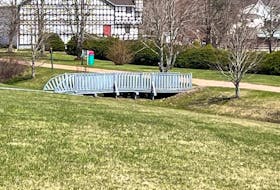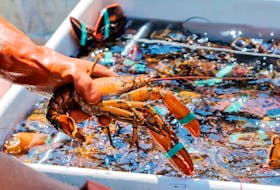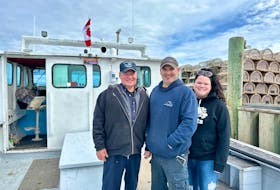ROBINSON'S ISLAND, P.E.I. - Thousands of shellfish have washed up on shore on Robinson’s Island in P.E.I.’s National Park.
The island is located just west of Brackley Beach.
Images of the carnage quickly made the rounds on social media, showing dead crabs, quahogs, clams and lobsters on shore in addition to rocks dragged in by the violent ocean waves.
Former Guardian photographer Brian McInnis, who now works as a freelancer, spotted the pictures on Facebook and quickly made his way out to Robinson’s Island. He was shocked by what he saw.
“It never crossed my mind that there would be this much damage,’’ McInnis said. “I got to the beach and was astounded as to the number of fair-sized stones . . . . and shellfish . . . that were thrown up.’’
McInnis said there was also quite a bit of damage done on land.
“You can see where the waves came up over the banks and into the woods. That was a really bad storm. There’s hiking trails on Robinson’s Island and there were trees down all over the place.’’
“There are natural mortalities in the population. I don’t expect you’ll see any local effect. We’re at a very high level of lobster population now, historically, and our monitoring that we do among the commercial fisheries shows very high numbers of legal-sized animals, so the population of the animals is at a very high level.’’
-Robert MacMillan
Robert MacMillan, a lobster biologist with the P.E.I. Department of Agriculture and Fisheries, said it is a naturally-occurring phenomenon.
“Typically, it happens more frequently in the fall of the year when you’ve got water starting to cool down and becoming more dense,’’ MacMillan said, adding that the high winds associated with these storms create big waves where lobsters and other invertebrates can be picked up by swells and thrown on shore.
“Some of those animals might be killed by impact and others may be broken into pieces and some of them are just stranded up out of the water and can’t return.’’
MacMillan isn’t sure how big the lobsters were but, judging by pictures he’s seen, most were smaller than legal size.
MacMillan also noted this type of fish kill shouldn’t affect the fishery.
“There are natural mortalities in the population. I don’t expect you’ll see any local effect. We’re at a very high level of lobster population now, historically, and our monitoring that we do among the commercial fisheries shows very high numbers of legal-sized animals, so the population of the animals is at a very high level.’’
The Department of Fisheries and Oceans added that it is illegal to harvest lobsters that have been washed ashore as a result of a storm surge.
“Under regulation . . . no person shall fish for lobster except from a vessel and with a lobster trap,’’ the DFO said in a written statement emailed to The Guardian. “This conservation measure is intended to protect the lobster biomass as well as the commercial lobster fishing industry.’’








